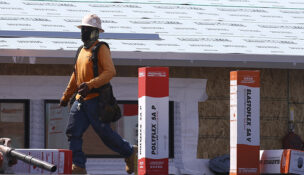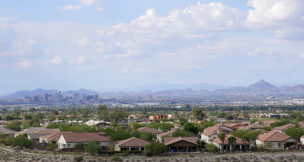Border crossers of another kind
Arizona Capitol Reports Staff//July 14, 2006//[read_meter]

‘Buffelgrass will provide fuel for fire inareas that don’t normally have fire.’
— Jeffrey Myers, noxious-weed program
Arizona is under attack by unwelcome guests from foreign soils and waters. Non-native plants have killed off fish, fueled wildfires, pushed out native flora and plagued crop production.
Then there’s the nightmare scenario. One water-loving species, if left unchecked, could clog up the very canals that deliver our drinking water.
But Arizona has a plan.
It’s outlined in a June 30 report by the Arizona Invasive Species Advisory Council, created by Governor Napolitano in 2005. Among other things, the council recommended a central clearinghouse to map and inventory invasive plants and animals.
That satisfies one requirement — know your enemy. What’s known already is the cost of invasive species to agriculture and forestry — some $138 billion annually nationwide, the report said. No figure is given for Arizona.
One culprit is buffelgrass, said Jeffrey Myers, noxious-weed program coordinator at the Arizona Department of Agriculture.
“Buffelgrass is a grass that’s closely related to fountain grass that’s used ornamentally,” said Mr. Myers, who sat on the advisory council. Fountain grass, by the way, is also an invasive species.
As for buffelgrass, it originally came from the arid regions of Africa. Like many invasive grasses, it thrives in the desert — often overtaking native plants.
Buffelgrass didn’t get here by accident, Mr. Myers said.
Cattle ranchers, with the help of the U.S. government, introduced it, according to a Pima County government fact sheet on the Internet.
“It was forage, mostly in Texas and Mexico,” Mr. Myers added. “It’s not in favor right now.”
For one thing, buffelgrass — along with other invasive plants — has made the Arizona deserts more prone to fires. It grows rapidly through winter and spring and dries out in the wilting heat of June, filling otherwise open spaces between cacti and other desert plants.
Fuel for fire
“It will provide fuel for fire in areas that don’t normally have fire,” Mr. Myers said.
In addition, it’s more fire resistant than many native desert plants. Fire does not kill off the buffelgrass, thanks to an extensive root system.
“The tops burn off, and it will grow back again,” Mr. Myers said.
For Meyers and the Agriculture Department, buffelgrass isn’t just an invasive species. It’s listed as a noxious weed. That means department officials can take steps to control it. They lack authority to go after invasive plants not listed as noxious.
Funds for education,
inspection stations
The advisory council recommended an approach that cuts across state agencies. Among other things, it proposed keeping the council on as a permanent invasive-species watchdog. In addition, the report said, an invasive-species center should be created to educate the public about the hazards posed by non-native plants, as well as animals. It also recommended more funding, but did not specify an amount. More money, for example, should be spent to bolster the state’s agricultural border inspection stations, one advisory council member said.
The inspection stations have been credited for barring the door to many a pest.
Red brome slipped in anyway.
To hear Ed Northam talk about it, red brome sounds a lot like buffelgrass — only worse. Mr. Brome is the program manager for invasive plants at the University of Arizona Agricultural Extension Service in Phoenix. He also sat on the advisory council.
Red brome — a non-native grass — did its part to spread the Cave Creek Complex fire northeast of Phoenix last summer, Mr. Northam said. The fire destroyed at least 10 homes. Much like the buffelgrass, red brome accounts for more frequent and hotter burning desert fires. And while fires might be considered natural to a forest, that’s not the case in the desert, Mr. Northam says.
“You burn a baby saguaro, and you’ve killed it,” he said.
Like buffelgrass, red brome made its way from other arid regions across the Atlantic — in this case from Mediterranean Europe and the Middle East. It was introduced to United States in the early 1900s.
Like buffelgras, it’s well established. And other bad plants are knocking at the door, including the hydrilla.
“It grows in the water and under the water,” Mr. Northam said. Then he added: “If it ever gets loose in our canal system and in our reservoirs, it would severely impact our ability to move water.”
It can overwhelm a canal and clog it up, he said. It was first introduced to Florida from South America as an ornamental plant for aquariums. Hydrilla has since spread to California, which has spent millions fighting it. Texas has its own hydrilla infestation.
Arizona, so far, has been lucky, Mr. Northam said.
“Right now, it’s in a couple of golf-course ponds,” he said.
Cactus moth
On land or on sea, the invasion is not just flora. There’s an assault from the non-native animal kingdom as well, the state report pointed out. The list includes bullfrogs, roof rats and insects.
Chris Trask of the Arizona Native Plant Society has his eye on one bug in particular. This is the cactus moth, which made it way to Texas from Argentina. It could devastate the state’s native cactus plants.
“It’s the cactus version of the Mediterranean fruit fly,” said Mr. Trask, also a member of the advisory council.
Mr. Northam said, however, it’s not entirely a one-way street. Farmers in North Africa and Australia have been battling a weed known as the silverleaf nightshade. It’s native to Arizona.

















